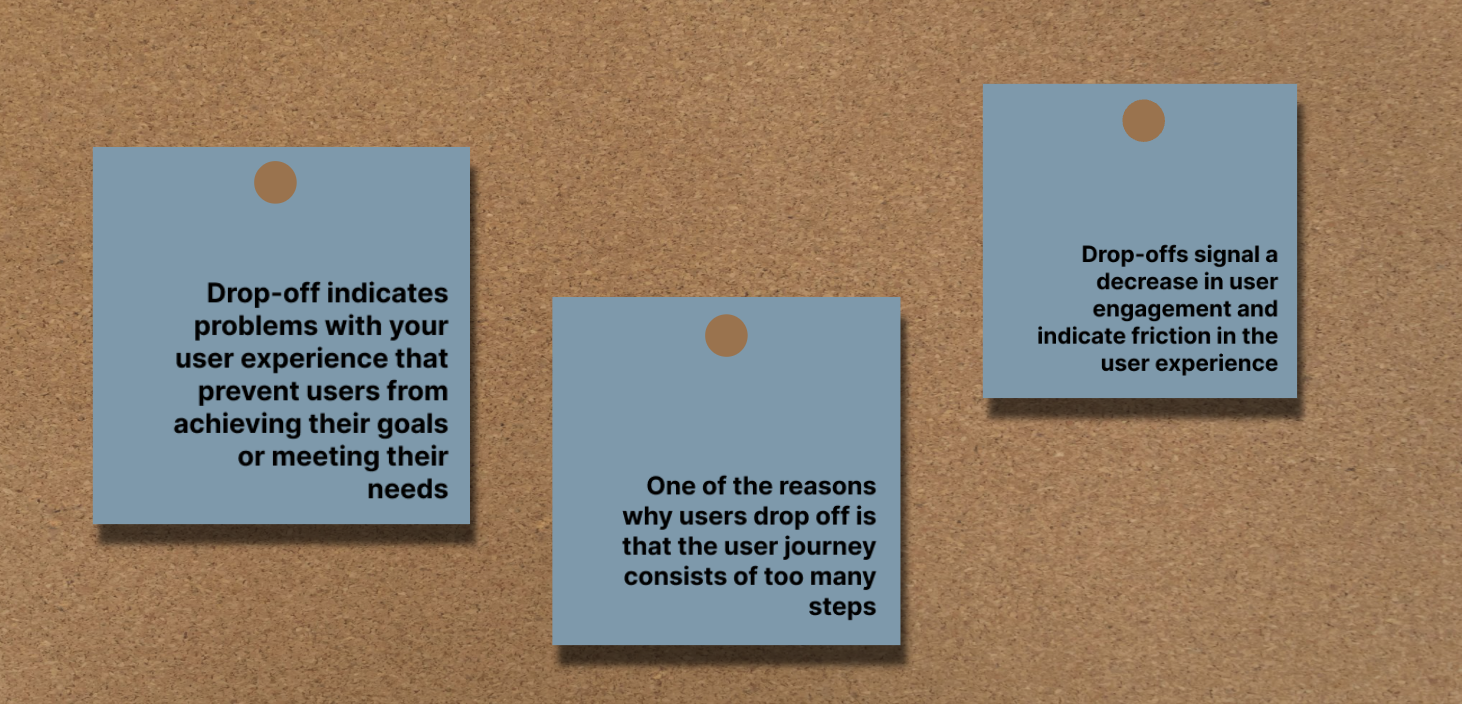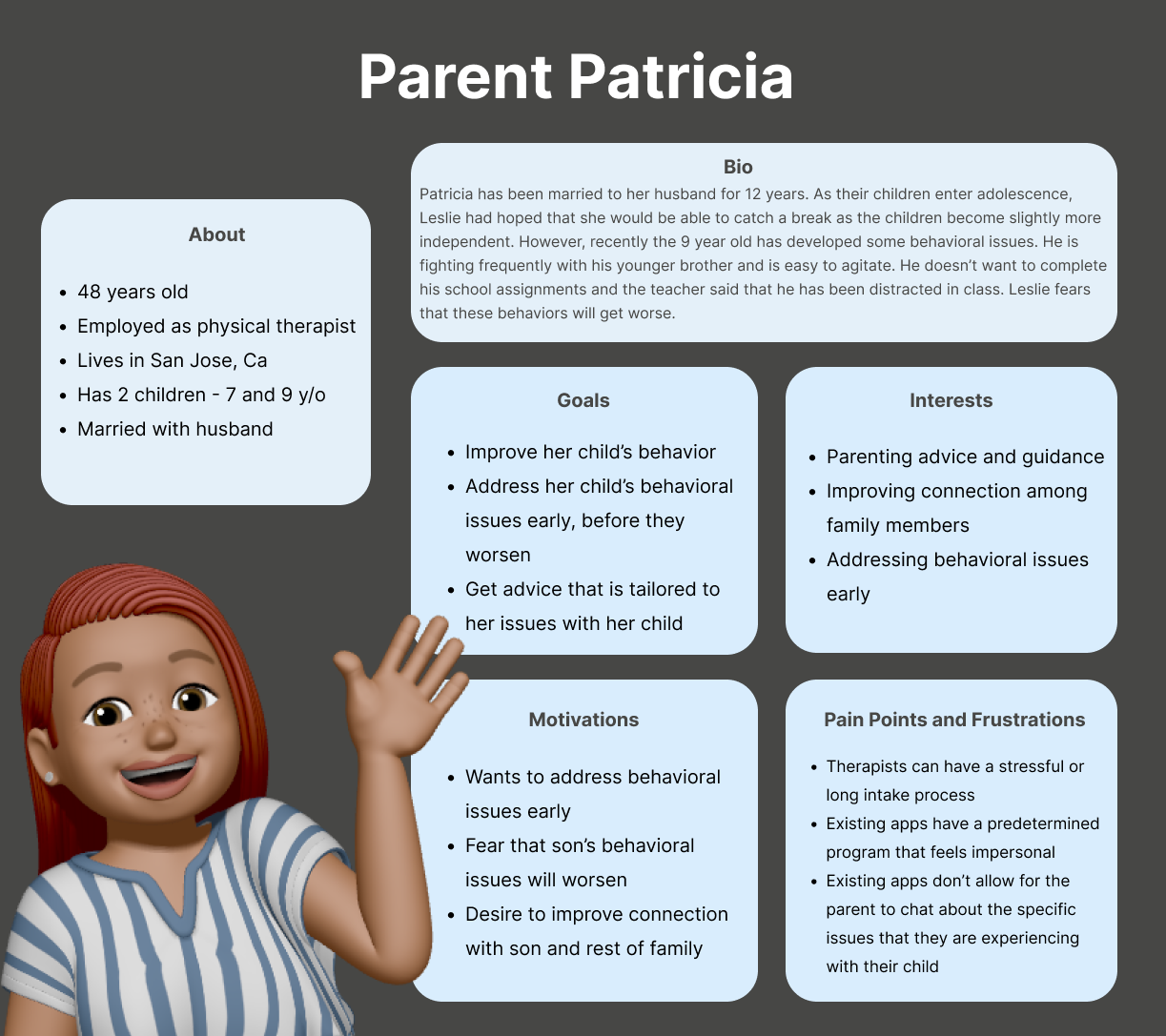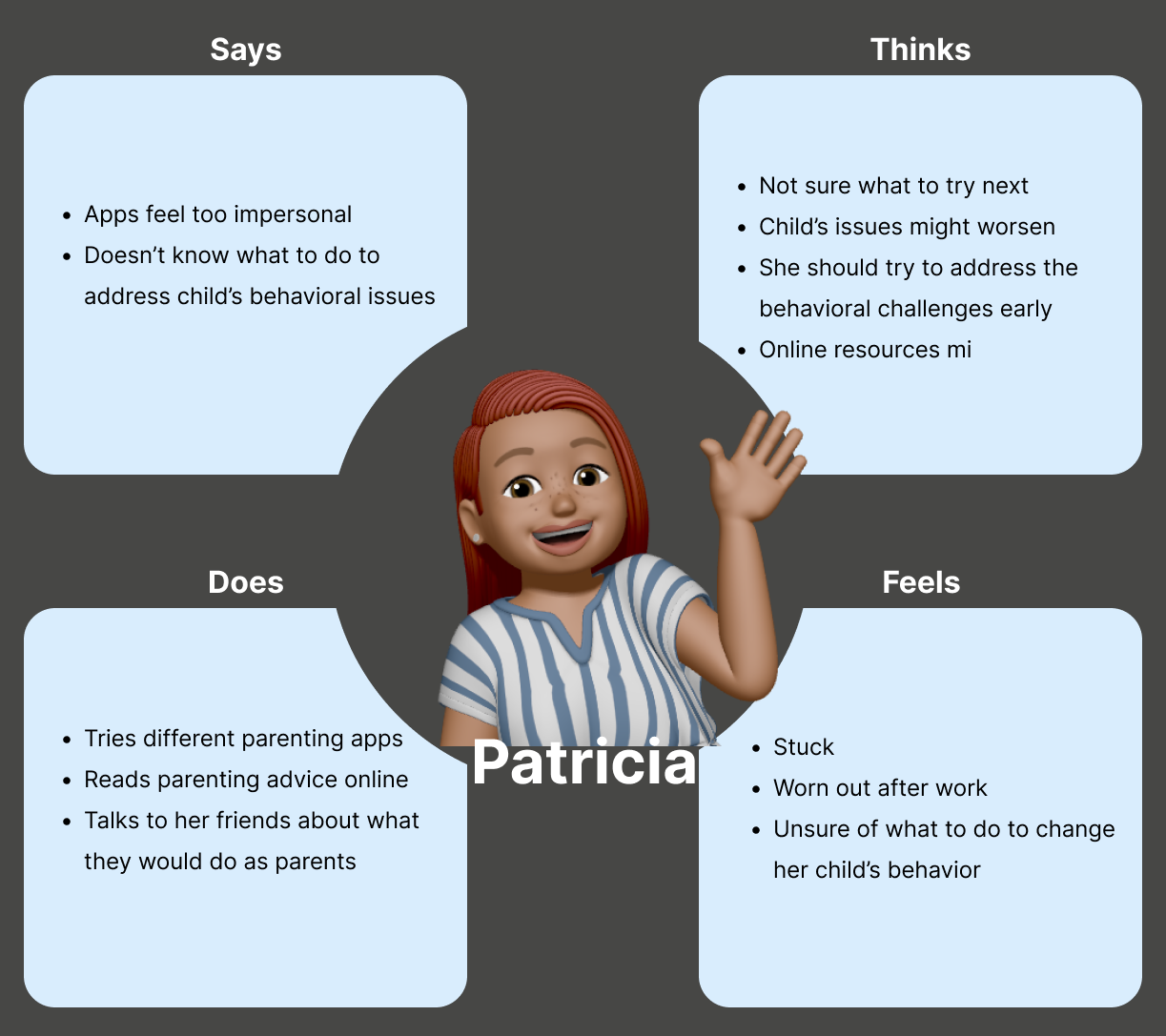The AI Chatbot For Parents
Parenting is one of life’s greatest challenges, especially for parents navigating the complexities of raising children with behavioral challenges or ADHD. As a UX researcher, I had the opportunity to contribute to an AI-powered mental health chatbot designed to assist and empower these parents. It uses evidence-based approaches to provide parents with the skills necessary to address their child’s unique situation.

The Problem
One of the projects I worked on during my year working on the chatbot was reducing user drop-off during onboarding on the website
Project Plan
Goals:
Reduce bounce rates during onboarding on web
Methodologies:
Secondary research on user drop-off
Competitive analysis to evaluate competition and highlight opportunities for improvement
Recruit participants that closely resemble the demographics and characteristics of the chatbot’s target users
Usability testing using the current web design
Affinity mapping to synthesize insights and find themes among the qualitative data
Personas to ensure the team is aligned on user needs
Empathy maps to deepen understanding of users and gain insight into their thoughts, feelings, and motivations
Iteration to retest the website
Highlights from Secondary Research
Competitive Analysis
We performed a competitive analysis that focused on the onboarding experience of similar apps. This analysis highlighted opportunities for improvement in the chatbot’s onboarding process.
Click to view the highlights from each organization’s onboarding experience:
-
Mood tracker - Can help keep track of a user’s emotions
Ask what a parent wants to work on - Asking right away what a parent wants to work on provides direction and structure
-
Include infographics - Can be more engaging for visual learners
Use of emojis - Personalizes the experience and adds fun
-
Providing specific options of what issues to work on - Makes PAT more customizable from the start
Option for PAT to be used as a program or autonomously - Allows PAT to accommodate for user preference
Ask how did you hear about us - Provides insight into which advertising strategies are working
-
Ask for parent and child pronouns - Can feel more inclusive and personable
-
Notifications/reminders - Notifications and reminders can help w/ engagement, retention, and keep parents on track and motivated
-
Multiple sign in options - More accessible bc people have different sign in preferences
-
Providing sample prompts - May be helpful for users who are stuck on what to ask PAT
-
Infographics and charts - More engaging for visual learners
Recruitment Process
With the chatbot’s target users in mind, we began the recruitment process.
Recruitment methods:
Each team member contacted personal connections they had who matched the demographics and characteristics of the chatbot’s target users
The team posted a recruitment message on the chatbot’s landing page that directed those who were interested to our contact info
The team posted on the chatbot’s instagram page in the form of a story and a post, inquiring about interest in participating in the study
We recruited 10 parents
5 mothers
5 fathers
Usability Testing
I conducted usability testing with the parents, where they chatted with the chatbot and answered questions. These revealed pain points, goals, and insights of its users.
Included questions about:
Additional features users might want to see in the future
Their overall impressions of the chatbot
Design preferences
Suggestions for improvement
Their experience interacting with the chatbot
Synthesizing Interview Insights
After gathering qualitative data in the interviews, I used affinity diagraming to identify patterns and themes among the data
We used these findings to inform design decisions and suggest changes to stakeholders
Theme 1 : Transparency
Users wanted more transparency about the information that goes into the chatbot
“I would rate [it] a 3/5 on reliability and trustworthiness because I don’t know what information went into [it]”
“I would appreciate a tab that provided information about [its] credentials. Maybe including the sources of the information that [it] provides”
ACTIONABLE INSIGHT:
Create a page that has information about the chatbot’s credentials and the evidence-based information that informs it’s responses
Theme 2 : Vocabulary
Several users noticed that there were multiple vocabulary or grammar errors in the chatbot’s responses to them
ACTIONABLE INSIGHT:
Change the remaining scripts from when the chatbot was primarily rule-based to be AI-based
Theme 3 : Integration with therapist
Users were receptive to combining the chatbot with therapist guidance, with some noting that they saw the chatbot as a complementary tool for additional support
Users said that they would be more inclined to use [it] if it was recommended by a therapist
“The bot is useful for weekends or days without therapist interactions”
“I think that [it] could be a great intake tool or as an initial try that may save a trip to the therapist”
ACTIONABLE INSIGHT:
Consider future therapist integration
Theme 4 : Specificity of responses
Users want the chatbot to incorporate prompts with specific examples and solutions
“I would like to see [it] provide more specific strategies”
“I would appreciate a little more guidance and information that is tailored to my child. I think intake should ask for more information about your child and the situation you are struggling with”
ACTIONABLE INSIGHT:
Finish switching the chatbot from rule-based to AI-based because it will be able to handle more complex, unstructured conversations
Theme 5 : Suggestions for features
Users suggested additional features that they’d like to see incorporated into the chatbot, including:
Links to more resources
Videos
Self check-ins
Saving conversations
Library of resources
Mood tracking
Ability to connect with a therapist
Visual progress report to track accomplishments
ACTIONABLE INSIGHT:
Consider incorporating suggested features in the future
Personas
To ensure our team stayed aligned with user needs, I created personas based on the data gathered from interviews
Empathy Maps
I created empathy maps to deepen my understanding of our users, including their thoughts, feelings, and motivations
In Conclusion
We successfully addressed the issue of user drop-off by implementing a series of actionable changes
By completing the transition from rule-based to AI-based, the chatbot was able to handle more complex interactions and cater its responses to be more specific to each user’s unique situation
We created a page with the chatbot’s credentials to establish credibility and increase trust with users
We explored potential features and prioritized adding a progress tracker and the ability to save conversations
We also implemented a few changes that improved the app’s overall usability
Ability to create an account and sign in, and overall streamlining of the sign-in process
Cleaner, more professional design that utilized muted colors
Iterative process
After implementation of the changes above, we tested the website again, with another round of 9 parents:
Feedback was more positive
In addition, the site analytics supported these findings:
People spent more time overall on the site
More people were completing the onboarding process
These findings indicate that we were successfully able to reduce user drop-off during the onboarding process

Reflection
By deeply exploring and understanding parents’ needs and collaborating with the UX team and stakeholders, I helped shape a product that offers practical and emotional support to those who need it most
The experience highlighted the importance of using research to inform design decisions. By iterating, we delivered a solution that not only functions effectively but also truly resonates with its users. These improvements in the user experience translated to a decrease in drop-off rates during the onboarding process
It was an honor to contribute to a project that empowers parents and helps create healthier, happier homes







